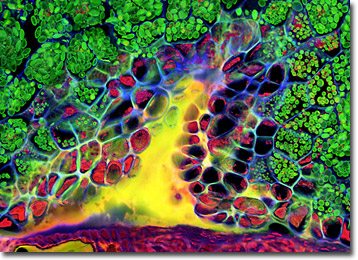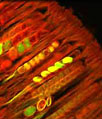 |
 |
 |
|
||||||||||||||||||||||||
 | ||||||||||||||||||||||||
 | ||||||||||||||||||||||||
 | ||||||||||||||||||||||||
Confocal Microscopy Image Gallery
Plant Tissue Autofluorescence Gallery
Wheat Grain
The term wheat is used to describe any of the cereal grasses of the genus Triticum and their consumable grain. Wheat grain consists of the small, dry fruit produced by the grasses.

The grains form at the head of the plant, which is comprised of alternating spikelets that may hold from one to five flowers. Each flower and the single ovary it holds is protected by membranous tissue collectively called the glume. Wheat is self-pollinating, and when the ovary is fertilized it develops into a kernel, or grain, a process that takes about a month.
The kernel color of wheat varies and may be any hue from white or yellow to amber or dark red. A brush of short hairs is often located at the apex of the grain and its ventral surface is creased. Each grain consists of three primary components: bran, endosperm, and germ. The outer and innermost portions (the bran and the germ, respectively) are usually separated from the endosperm that lies between them during milling. The endosperm, which is high in starch and composes the bulk of the grain, is then commonly utilized to produce white flour.
Wheat is one of the most important human food sources in the world and is thought to have been cultivated for consumption for about 9,000 years. Today the amount of farmland utilized around the world to grow wheat is greater than that for any other food crop. The dried grain can be stored for significant amounts of time, and ease of handling the material enables it to be shipped to distant locations without loss of quality.
Additional Confocal Images of Wheat Grain
Wheat Grain at Low Magnification - The fully developed wheat grain is roughly ovate in shape and measures approximately 0.15 to 0.4 inches in length depending on the specific type of plant from which it is harvested.
Wheat Grain at High Magnification - The longevity of wheat is heavily dependent on its maintenance in dry conditions because damp grain is very susceptible to mold growth and the proliferation of insects.
Contributing Authors
Nathan S. Claxton, Shannon H. Neaves, and Michael W. Davidson - National High Magnetic Field Laboratory, 1800 East Paul Dirac Dr., The Florida State University, Tallahassee, Florida, 32310.
